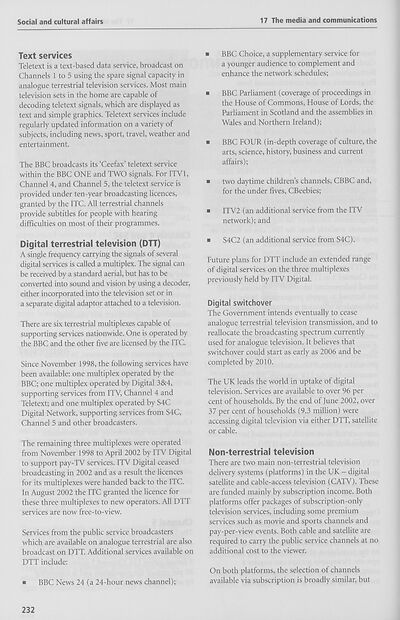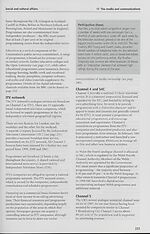Download files
Complete book:
Individual page:
Thumbnail gallery: Grid view | List view

Social and cultural affairs
17 The media and communications
Text services
Teletext is a text-based data service, broadcast on
Channels 1 to 5 using the spare signal capacity in
analogue terrestrial television services. Most main
television sets in the home are capable of
decoding teletext signals, which are displayed as
text and simple graphics. Teletext services include
regularly updated information on a variety of
subjects, including news, sport, travel, weather and
entertainment.
The BBC broadcasts its ‘Ceefax’ teletext service
within the BBC ONE and TWO signals. For ITV1,
Channel 4, and Channel 5, the teletext service is
provided under ten-year broadcasting licences,
granted by the ITC. All terrestrial channels
provide subtitles for people with hearing
difficulties on most of their programmes.
Digital terrestrial television (DTT)
A single frequency carrying the signals of several
digital services is called a multiplex. The signal can
be received by a standard aerial, but has to be
converted into sound and vision by using a decoder,
either incorporated into the television set or in
a separate digital adaptor attached to a television.
There are six terrestrial multiplexes capable of
supporting services nationwide. One is operated by
the BBC and the other five are licensed by the ITC.
Since November 1998, the following services have
been available: one multiplex operated by the
BBC; one multiplex operated by Digital 3&4,
supporting services from ITV, Channel 4 and
Teletext; and one multiplex operated by S4C
Digital Network, supporting services from S4C,
Channel 5 and other broadcasters.
The remaining three multiplexes were operated
from November 1998 to April 2002 by ITV Digital
to support pay-TV services. ITV Digital ceased
broadcasting in 2002 and as a result the licences
for its multiplexes were handed back to the ITC.
In August 2002 the ITC granted the licence for
these three multiplexes to new operators. All DTT
services are now free-to-view.
Services from the public service broadcasters
which are available on analogue terrestrial are also
broadcast on DTT. Additional services available on
DTT include:
■ BBC News 24 (a 24-hour news channel);
■ BBC Choice, a supplementary service for
a younger audience to complement and
enhance the network schedules;
■ BBC Parliament (coverage of proceedings in
the House of Commons, House of Lords, the
Parliament in Scotland and the assemblies in
Wales and Northern Ireland);
■ BBC FOUR (in-depth coverage of culture, the
arts, science, history, business and current
affairs);
■ two daytime children’s channels, CBBC and,
for the under fives, CBeebies;
■ ITV2 (an additional service from the ITV
network); and
■ S4C2 (an additional service from S4C).
Future plans for DTT include an extended range
of digital services on the three multiplexes
previously held by ITV Digital.
Digital switchover
The Government intends eventually to cease
analogue terrestrial television transmission, and to
reallocate the broadcasting spectrum currently
used for analogue television. It believes that
switchover could start as early as 2006 and be
completed by 2010.
The UK leads the world in uptake of digital
television. Services are available to over 96 per
cent of households. By the end of June 2002, over
37 per cent of households (9.3 million) were
accessing digital television via either DTT, satellite
or cable.
Non-terrestrial television
There are two main non-terrestrial television
delivery systems (platforms) in the UK - digital
satellite and cable-access television (CATV). These
are funded mainly by subscription income. Both
platforms offer packages of subscription-only
television services, including some premium
services such as movie and sports channels and
pay-per-view events. Both cable and satellite are
required to carry the public service channels at no
additional cost to the viewer.
On both platforms, the selection of channels
available via subscription is broadly similar, but
232
17 The media and communications
Text services
Teletext is a text-based data service, broadcast on
Channels 1 to 5 using the spare signal capacity in
analogue terrestrial television services. Most main
television sets in the home are capable of
decoding teletext signals, which are displayed as
text and simple graphics. Teletext services include
regularly updated information on a variety of
subjects, including news, sport, travel, weather and
entertainment.
The BBC broadcasts its ‘Ceefax’ teletext service
within the BBC ONE and TWO signals. For ITV1,
Channel 4, and Channel 5, the teletext service is
provided under ten-year broadcasting licences,
granted by the ITC. All terrestrial channels
provide subtitles for people with hearing
difficulties on most of their programmes.
Digital terrestrial television (DTT)
A single frequency carrying the signals of several
digital services is called a multiplex. The signal can
be received by a standard aerial, but has to be
converted into sound and vision by using a decoder,
either incorporated into the television set or in
a separate digital adaptor attached to a television.
There are six terrestrial multiplexes capable of
supporting services nationwide. One is operated by
the BBC and the other five are licensed by the ITC.
Since November 1998, the following services have
been available: one multiplex operated by the
BBC; one multiplex operated by Digital 3&4,
supporting services from ITV, Channel 4 and
Teletext; and one multiplex operated by S4C
Digital Network, supporting services from S4C,
Channel 5 and other broadcasters.
The remaining three multiplexes were operated
from November 1998 to April 2002 by ITV Digital
to support pay-TV services. ITV Digital ceased
broadcasting in 2002 and as a result the licences
for its multiplexes were handed back to the ITC.
In August 2002 the ITC granted the licence for
these three multiplexes to new operators. All DTT
services are now free-to-view.
Services from the public service broadcasters
which are available on analogue terrestrial are also
broadcast on DTT. Additional services available on
DTT include:
■ BBC News 24 (a 24-hour news channel);
■ BBC Choice, a supplementary service for
a younger audience to complement and
enhance the network schedules;
■ BBC Parliament (coverage of proceedings in
the House of Commons, House of Lords, the
Parliament in Scotland and the assemblies in
Wales and Northern Ireland);
■ BBC FOUR (in-depth coverage of culture, the
arts, science, history, business and current
affairs);
■ two daytime children’s channels, CBBC and,
for the under fives, CBeebies;
■ ITV2 (an additional service from the ITV
network); and
■ S4C2 (an additional service from S4C).
Future plans for DTT include an extended range
of digital services on the three multiplexes
previously held by ITV Digital.
Digital switchover
The Government intends eventually to cease
analogue terrestrial television transmission, and to
reallocate the broadcasting spectrum currently
used for analogue television. It believes that
switchover could start as early as 2006 and be
completed by 2010.
The UK leads the world in uptake of digital
television. Services are available to over 96 per
cent of households. By the end of June 2002, over
37 per cent of households (9.3 million) were
accessing digital television via either DTT, satellite
or cable.
Non-terrestrial television
There are two main non-terrestrial television
delivery systems (platforms) in the UK - digital
satellite and cable-access television (CATV). These
are funded mainly by subscription income. Both
platforms offer packages of subscription-only
television services, including some premium
services such as movie and sports channels and
pay-per-view events. Both cable and satellite are
required to carry the public service channels at no
additional cost to the viewer.
On both platforms, the selection of channels
available via subscription is broadly similar, but
232
Set display mode to:
![]() Universal Viewer |
Universal Viewer | ![]() Mirador |
Large image | Transcription
Mirador |
Large image | Transcription
The item on this page appears courtesy of Office for National Statistics and may be re-used under the Open Government Licence for Public Sector Information.
| Britain and UK handbooks > UK: The official yearbook of the United Kingdom of Great Britain and Northern Ireland > 2003 > (254) |
|---|
| Permanent URL | https://digital.nls.uk/204926412 |
|---|
| Attribution and copyright: |
|
|---|---|
| Description | Three volumes of 'UK: The official yearbook of the United Kingdom of Great Britain and Northern Ireland', published annually by the Office of National Statistics from 2002-2005. |
|---|---|
| Shelfmark | GII.11 SER |
| Description | Three titles produced by the British Government from 1954-2005 describing 'how Britain worked'. They are: 'Britain: An official handbook' (1954-1998), 'Britain: The official yearbook of the United Kingdom' (1999-2001), and 'UK: The official yearbook of the United Kingdom of Great Britain and Northern Ireland' (2002-2005). These 50 reports provide an overview of Britain's economic, social and cultural affairs, its environment, international relations, and the systems of government. They give an impartial summary of government policies and initiatives, and explain how public services are organised. |
|---|---|
| Additional NLS resources: |
|

